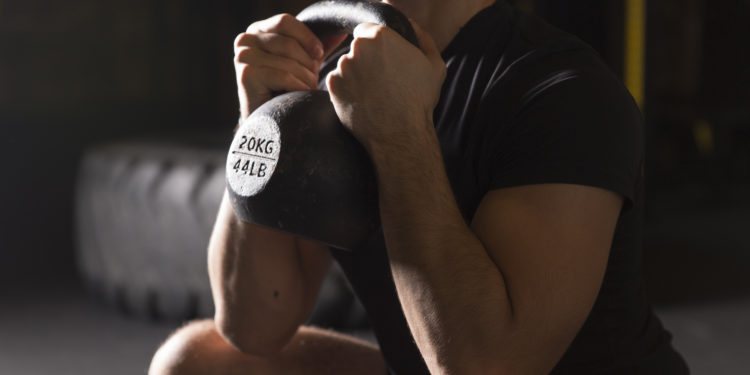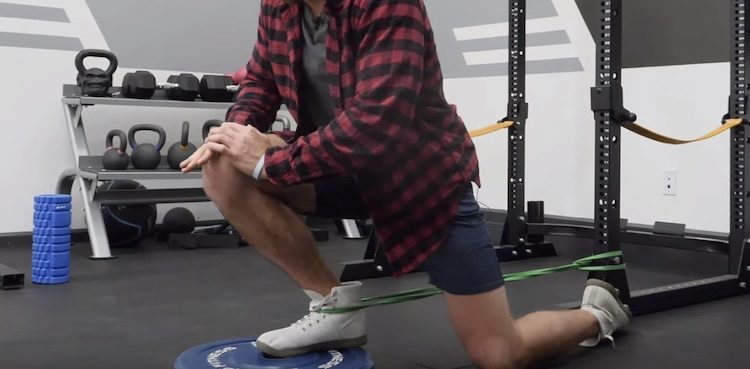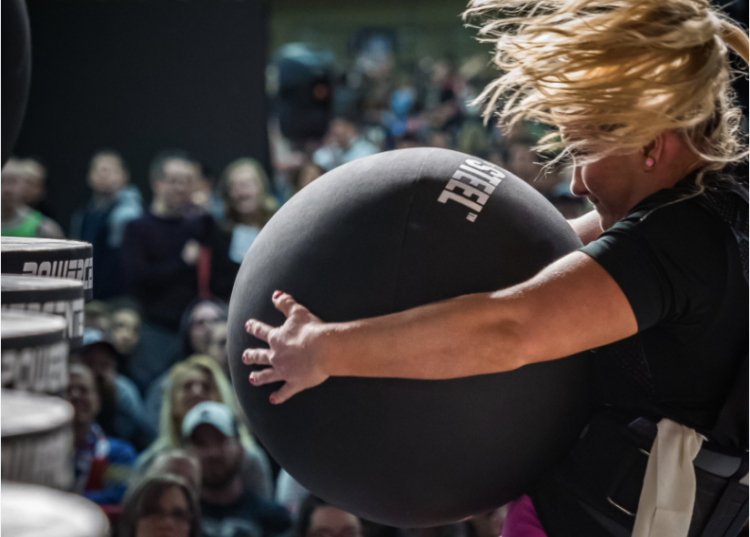You don’t have to be back in the gym and reunited with your favorite squat rack to get rid of your good morning squat. Don’t get me wrong — good mornings are great. Squats are delightful.
But you never want to accidentally combine them.
Fixing your good morning squat is definitely going to be a priority if you want to be as prepared as possible to dive back into your barbells — so it’s good news that you can start the work at home.
Editor’s note: This article is an op-ed. The views expressed herein and in the video are the author’s and don’t necessarily reflect the views of BarBend. Claims, assertions, opinions, and quotes have been sourced exclusively by the author.
View this post on Instagram
What Is A Good Morning Squat?
A good morning squat is called that because after you hit depth, you hinge the weight up with brute force rather than squatting it up with a straight bar path.
Everyone has different limb lengths and body types, so what seems like a good morning squat is going to vary from person to person. That said, there is a general trend to look for with your back squat. Whether you’re doing low bar or high bar, good morning squats might be an issue for you, though because of the bar position, they’ll probably be a bigger obstacle during low bar squats.
Either way, you might not be able to feel a good morning squat while you’re doing it. When you’re focused on squatting to depth, once you get low enough, you’re usually so focused on ascending back to standing that how your body accomplishes that can get lost in the shuffle.
Of course, leaning forward a bit (especially with a low bar squat) is pretty natural for many lifters, given that the slight lean can help keep the bar path directly over your feet (which is what you want). But, here’s how to know you’re “good morning” squatting and probably should adjust your form — video yourself from the side during your heavy sessions (or review old videos).
In a good morning squat, your hips will rise faster than your shoulders, causing your body to sort of fold in on itself as you rise.
You might get the bar up and complete your squat to standing, but with your hips going faster than your shoulders, the lift will start to resemble a good morning. Ideally, your shoulders and hips should be rising at the same time, and that’s what you want to drive toward.
[Related: Why Your Workouts Need More (Proper) Good Mornings]
Why Are Good Morning Squats a Bad Idea?
When your hips rise faster than your shoulders, your torso collapses at an undesirable angle toward your thighs.
When that happens, your low back takes on an inappropriate amount of strain. Instead of the power of your lift coming from your hips, glutes, and legs, your low back bears the brunt of the bar. At that compromised angle, your low back isn’t only taking care of the weight itself (which, if your form is breaking down like this, is probably significant), it’s also trying to resist the shearing forces from keeping the bar pulling directly down.
Think about it this way: hold a heavy dumbbell in a goblet squat position. It’ll naturally fall in line with the center of gravity, over your midfoot.
But if you push the dumbbell out away from you by extending your arms, you’re shifting the center of gravity outward. The dumbbell suddenly feels almost impossibly heavy, because you’re holding it out in front of you but it’s tugging straight down. Now imagine that instead of a dumbbell pulling down on your outstretched hands, it’s a much heavier, loaded barbell, tugging down on your upper back with your legs bent in a squat and your hips almost as high as your shoulders. That… isn’t a good look.
More importantly, your low back just can’t take that pressure and those directional forces. Sure, you’ll probably be able to force the bar into standing position, but over time, good morning squats are just going to give you near constant low back pain because your spinal erectors will be inappropriately engaged in trying to keep the bar from tugging you down and forward.
It’s well worth it to strip a lot of weight off the bar and build the weight back up with proper form, rather than continuing at a heavier weight with a form that’s almost a guaranteed injury. In addition, whether you have access to barbells now or you’re just training from home with little or no weights, you can do a lot of work at home to fix your good morning squat.

How To Fix A Good Morning Squat At Home
Of course, if you want to fix your squat, there’s not really a replacement for getting into a rack and practicing pristine form.
But if the only thing you’re doing to get rid of your good morning squat is squatting, it probably won’t be enough to save your low back. Make sure to integrate moves to fix your good morning squat at home — or on the stretch mat — and you’re bound to see an improvement in your form (and your low back risks).

Ankle And Hip Mobility
In the beginning of quarantine, you might have jumped into mobility work with gusto — this will make me that much better to get back to traditional lifting, you said (and you were right). But then… quarantine just didn’t end. It might be getting harder to keep up your mobility work the longer you can’t go to the gym — but even when you can get back to the gym, you’re definitely going to need to keep up your mobility work for the sake of your gains.
If you haven’t already integrated ankle and hip mobility into your squatting routine, you should start ASAP. Opening up your ankles with moves like lateral ankle lunges and frog stretches for your hip mobility is going to work wonders for your ability to sink down into a proper deep squat without having to resort to compensation (like falling way forward with your torso).
Aim to integrate at least a few sets of ankle and hip mobility work into each day. Maybe it’s with your workout warmup, or maybe it’s throughout your work from home schedule — either way, opening your ankles and hips will optimize your form and force direction precisely when the squat gets tough. You’ll set yourself up for success before you even begin the dreaded good morning tilt.
Play With Tempo
Even working just with bodyweight, tempo work is going to help your squat form quite a bit.
To maximize the benefits, pretend to have a loaded bar on your back — brace your core, engage your lats, and position your hands and elbows just like you have an imaginary bar pinned to your shelf. Maintain this positional integrity throughout the move. It’ll engage more of your muscles and more of your mind, keeping you focused on visualizing a barbell rather than going through the motions of a weightless squat.
Descend slowly — think counts as long as seven — pausing just above your bottom range to stall any momentum or slack all the way down. Check in with yourself at the bottom of the squat to make sure your chest is up. Of course, it doesn’t have to be (and shouldn’t be) completely upright, but make sure you’re not hinging down so the bottom of your squat looks like you’re setting up for a deadlift. You definitely don’t want that. Remember that you’re holding an imaginary barbell on your back, and as you start to (slowly) rise, make sure to keep that bar path over your midfoot. Keep it slow to ingrain that positive movement pattern.
For some of your squats, do everything as if you’re moving through molasses. For other sets, focus on slowing down your descent; others, your ascent; and others, keep regular speed on the up and down, and keep a 10- or 20-second hold just above your bottom position. Playing with speed in these ways — especially if you maintain that faux bar integrity — will help get your body used to the bar path it’s supposed to follow under heavy loads.
Bottom-Up Squats
Assume your squat position with your feet, but instead of squatting right down, hinge first.
With soft knees, hinge down so your fingers touch your toes or you feel a stretch in your hamstrings (whichever comfortably comes first). When you get there, begin your squat, sinking down into your bottom position. As you do so, keep your arms straight (soft elbows are fine) and engage your lats to raise your arms above your head — like you would with a barbell overhead squat. Maintain that integrity in your torso as you squat up to standing. Rinse and repeat.
The movement pattern you’ll be developing will help train your body to keep your lats and core engaged throughout the squat, which is precisely one of the things you’ll need to build up to prevent good morning squats.
Strengthen Your Quads
You might well have a hip-dominant squat naturally — and that’s okay. But when your hips are taking over to overcompensate for weak quads (transferring a dangerous amount and direction of force into your low back), trouble can start up.
Integrate plenty of lunges, Bulgarian split squats, tempo split squats, and lateral lunges into your at-home routine to make sure you’re developing the quad strength you need to get a loaded barbell up without shooting your hips up faster than your shoulders.
Getting your quads as solid as can be (while not, of course, reversing direction and neglecting your glutes and hamstrings) will help you raise your hips and shoulders at the same time, eliminating the good morning squat and sparing your form.
Front-Load Your Squats
Yes, this is part of strengthening your quads, but it’s also about getting your mind set on the proper mechanics. If you’ve got anything you can load at home — a backpack with the entire Harry Potter series, worn backwards; a dumbbell or kettlebell you can goblet or front rack; a couple of filled milk jugs — take the concept of pattern reinforcement and apply it to front-loaded squats. Goblets, double rack, single rack, even unilaterally-loaded lunges and reverse lunges will be helpful here.
[Related: 4 Household Items That Can Double as Workout Equipment]
Wake Up Your Squat
There’s nothing quite like a solid squat session to start your day, but combining good mornings with your squat form is far from a good idea. But rest assured: you can protect your low back and improve your squat form, all while training at home.
Featured image via Photology1971/Shutterstock
